Have you ever wondered how a simple rock could revolutionize our energy future? Shale rock isn’t just another stone it’s a geological time capsule holding ancient organic matter that has transformed into one of the most valuable energy resources of the 21st century.
Here’s what you can expect to learn in this article:
What is shale?
Definition of shale: shale is a fine-grained clastic sedimentary rock formed from the compaction of mud, silt and clay-sized mineral particles. It typically develops in slow-moving water environments such as lakes, river deltas and deep-sea floors, resulting in a finely laminated structure. This rock is the most abundant sedimentary rock and plays a crucial role in energy production, fossil preservation as well as construction.
This article will take you on a journey through the fascinating world of shale rock. You’ll discover how this remarkable sedimentary formation has been millions of years in the making, how geologists classify its various types, and why it has become the centerpiece of a global energy revolution. Whether you’re a geology enthusiast, a student, or simply curious about the natural resources shaping our world, you’ll find valuable insights that will forever change how you think about the ground beneath your feet.
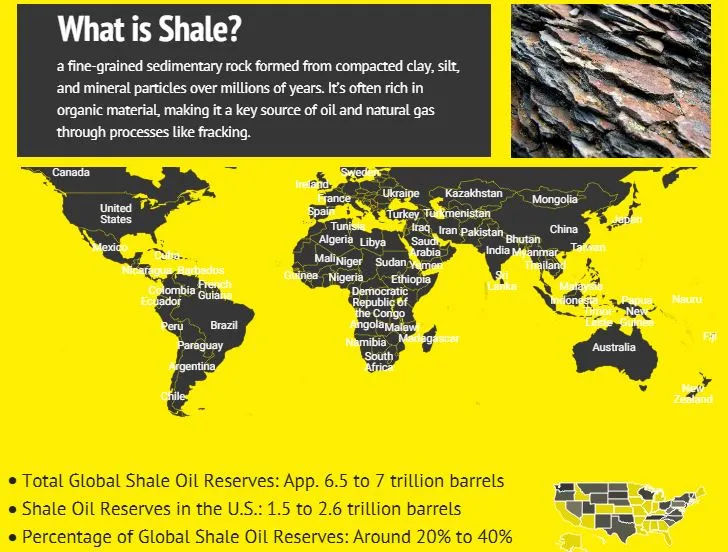
How Shale is Formed?
Shale formation occurs over millions of years through the accumulation and compression of fine-grained sediments. This sedimentary rock is primarily composed of clay minerals, quartz, and organic matter that transform through geological processes spanning vast time periods.
Formation Process of Shale
The formation of shale begins with sediment deposition, where tiny clay and silt particles settle in calm, low-energy environments such as lakes, river deltas, and deep ocean floors. These environments provide the perfect conditions for the fine particles to gradually accumulate without being disturbed by strong currents.
As time passes, layers of sediment continue to build up, and the pressure from the overlying materials compresses the lower layers. This compaction process squeezes out water and begins the transformation of loose sediment into solid rock. The process continues with cementation, where minerals like silica, calcite, and iron oxides help bind the particles together, further solidifying the rock structure.
In oxygen-poor environments, organic material trapped within the developing shale may be preserved rather than decomposed. This preserved organic matter is particularly significant, as it may eventually transform into valuable hydrocarbons like oil and natural gas under the right conditions of heat and pressure.
Where is Shale Found?
Shale is abundant worldwide, often forming in sedimentary basins where fine particles accumulate over time. These basins can be found across continents and geological periods. Major shale formations exist in the United States (particularly in the Marcellus, Eagle Ford, and Bakken regions), China (with extensive deposits in the Sichuan Basin), Argentina (in the Vaca Muerta formation), and Canada (with significant deposits in Alberta and British Columbia). These formations vary in age, composition, and hydrocarbon potential, making each unique in its characteristics and economic value
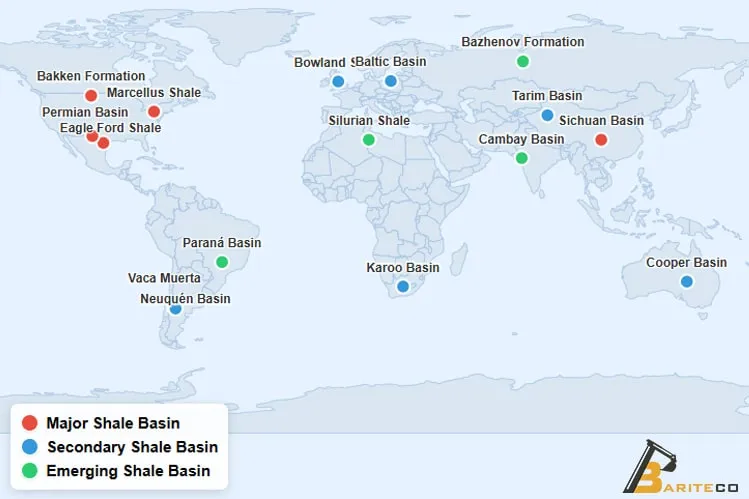
Uses of Shale
Shale has become increasingly important for oil and gas extraction, with formations containing significant reserves of shale oil and shale gas that have revolutionized energy markets in recent decades. The development of hydraulic fracturing and horizontal drilling technologies has made these previously inaccessible resources economically viable.
Beyond energy applications, shale serves as an essential material in construction, where it’s incorporated into bricks, cement, and ceramics. Its fine-grained nature and mineral composition make it particularly suitable for these applications, providing durability and structural integrity.
Some types of shale also possess natural impermeability, making them excellent for waterproofing applications. This property is utilized in landfills and reservoirs, where shale layers can act as natural barriers to prevent water and contaminant migration, protecting surrounding environments and water sources.
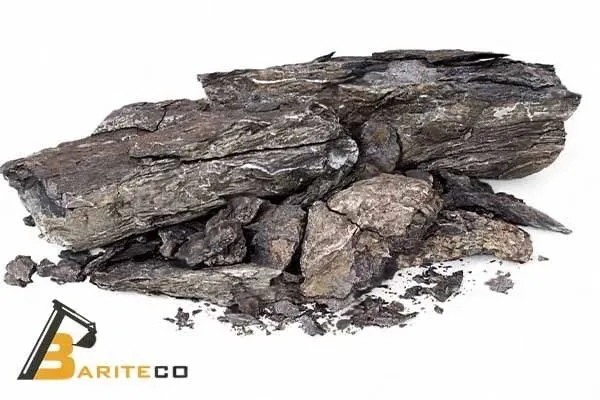
Composition of Shale
Shale is a fine-grained sedimentary rock with a complex mineralogical makeup that defines its physical properties and economic potential. Clay minerals form the dominant component of shale, including varieties such as kaolinite, illite, and montmorillonite. These microscopic clay particles give shale its characteristic fine texture and contribute to its unique physical properties, particularly its ability to split along parallel planes.
Within the shale matrix, quartz and feldspar minerals provide essential structural strength and hardness. Though present in smaller quantities than clay minerals, these silicate components significantly enhance the rock’s durability and resistance to weathering processes, contributing to shale’s preservation in the geological record over millions of years.
Many economically important shales contain significant amounts of organic material derived from ancient plant and animal remains. This organic content is particularly valuable as it serves as the precursor to hydrocarbons, potentially leading to the formation of shale oil and natural gas under appropriate temperature and pressure conditions. The organic content often determines a shale formation’s energy resource potential.
Carbonate minerals, primarily calcite and dolomite, are present in varying amounts in different shale varieties. These minerals contribute to the cementation process that binds the fine particles together, influencing the rock’s overall cohesiveness and structural integrity. Shales with higher carbonate content may exhibit different weathering characteristics and economic applications.
The coloration of shale largely depends on the presence of iron oxides and sulfides. These compounds create the distinctive red, green, or black appearance of different shale varieties, reflecting the environmental conditions present during formation. The color often provides valuable insights into the depositional environment and oxygen levels present when the sediments accumulated.
Characteristics of Shale
The fine-grained texture of shale results from the microscopic clay and silt particles that comprise its structure. This characteristic gives shale a smooth, often soft feel when weathered and contributes to its behavior when used in various applications. The fine grain size also affects how shale weathers and erodes compared to coarser-grained sedimentary rocks.
One of shale’s most distinctive properties is its fissility—the ability to split easily into thin layers along parallel planes. This characteristic results from the alignment of flat clay minerals during deposition and compaction, creating weakness planes throughout the rock. Fissility greatly influences how shale is quarried, processed, and utilized in construction and other applications.
The color variation in shale provides important clues about its composition and formation environment. Black shale typically contains high organic content, often indicating deposition in oxygen-poor environments that preserved carbon-rich material. These dark-colored shales frequently represent potential source rocks for petroleum. Red or green shales derive their coloration from iron compounds or chlorite minerals, reflecting different oxidation states present during or after deposition.
Shale exhibits remarkably low permeability, meaning fluids and gases cannot easily pass through it. This characteristic makes shale an effective natural barrier in geological settings, preventing the migration of oil, gas, and water between rock layers. This same property is deliberately utilized in environmental engineering, where shale serves as a natural containment material in waste disposal sites and water reservoirs.
The sedimentary environments where shale forms often provide ideal conditions for fossil preservation. Fine particles quickly entomb organisms, protecting them from decomposition and disturbance. As a result, shale formations frequently contain well-preserved fossils of plants, invertebrates, and occasionally vertebrates. These fossil assemblages offer valuable insights into ancient ecosystems and evolutionary history, making shale deposits significant for paleontological research and our understanding of Earth’s biological past.
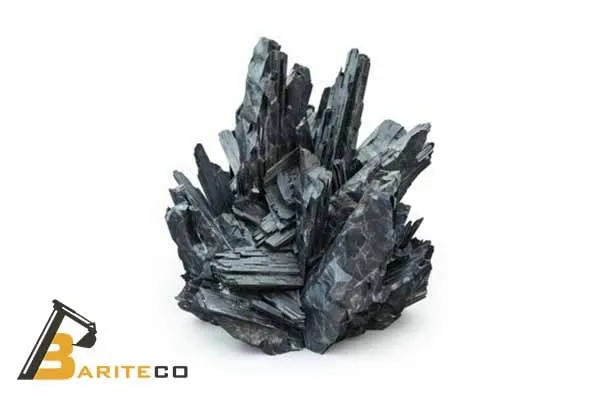
Types of Shale Rock
Shale rocks vary significantly based on composition, color, and organic content. These variations reflect different depositional environments and subsequent geological processes, resulting in distinct types with unique properties and economic significance. Next, we will introduce these stones.
1- Black Shale
- Rich in organic material and may contain significant quantities of oil or natural gas
- Often found in marine environments where organic matter accumulates without complete decomposition
- Functions as an important source rock for petroleum and natural gas resources
- The dark coloration comes from preserved carbon-rich organic materials
2- Red and Green Shale
- Red shale contains iron oxides (primarily hematite), giving it a distinctive reddish color
- Green shale gets its coloration from chlorite minerals or ferrous iron compounds
- Typically forms in oxidizing environments, such as floodplains and shallow marine settings
- The color variations provide valuable information about the oxidation conditions during deposition
3- Carbonate-Rich Shale
- Contains significant amounts of calcite or dolomite in addition to clay minerals
- More resistant to weathering compared to other shale types due to carbonate content
- Often associated with marine sedimentary basins where limestone and shale deposition occurred together
- May appear lighter in color than typical shales
4- Siliceous Shale
- High in silica (quartz) content, making it exceptionally hard and brittle
- May contain microcrystalline quartz, chert nodules, or radiolarian fossils
- Typically forms in deep-sea environments where silica-rich organisms accumulated
- Often more resistant to weathering than clay-rich shales
5- Oil Shale
- Contains kerogen, a solid organic material that can be converted into oil through heating processes
- Found primarily in regions with ancient lakes or shallow seas that preserved abundant organic matter
- Represents a significant potential source of unconventional petroleum through retorting processes
- Often has a brownish to black appearance and may have a waxy texture
6. Ferruginous Shale
- Rich in iron compounds, sometimes forming concentrated iron ore deposits
- Found in both marine and lacustrine (lake) environments under specific chemical conditions
- May show bands or nodules of iron minerals throughout the shale matrix
- Can be economically important for iron and steel production in some regions
Comparative Analysis of Shale Types
| Type of Shale | Key Features | Environment of Formation | Uses/Significance |
| Black Shale | High organic material, potential for oil/gas | Marine environments with high organic content | Source rock for petroleum and natural gas |
| Red Shale | Contains iron oxides, reddish color | Oxidizing environments (floodplains, deserts) | Common in terrestrial and fluvial deposits |
| Green Shale | Contains chlorite or ferrous iron, green color | Similar to red shale, with reduced oxidation | Found in wetlands or floodplains |
| Carbonate-Rich Shale | High in calcite or dolomite, more resistant to weathering | Marine sedimentary basins | Used in construction and as a natural barrier |
| Siliceous Shale | High silica (quartz), brittle, hard | Deep-sea environments | Contains radiolarian fossils, valuable for geological studies |
| Oil Shale | Rich in kerogen, potential for oil production | Ancient lakes or shallow seas | Source of unconventional petroleum (after heating) |
| Ferruginous Shale | Rich in iron compounds | Marine or lacustrine environments | Important in iron ore deposits and used for steel production |
Understanding the different types of shale is crucial for geologists, energy companies, and industries that utilize these resources. Each variety offers unique properties and potential applications, from energy production to construction materials. The specific characteristics of shale can provide valuable insights into Earth’s geological history and the environmental conditions that prevailed during their formation.
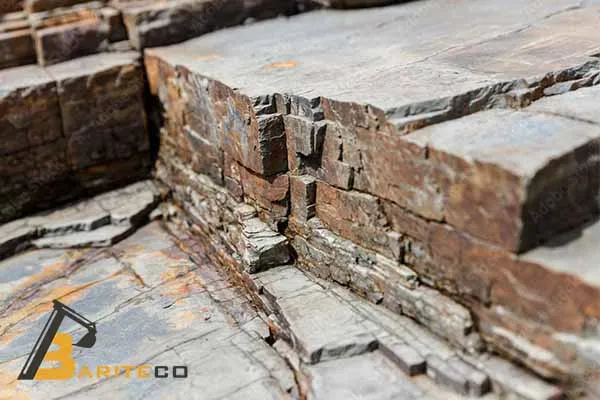
Shale vs Slate: A Detailed Comparison
Shale and slate are often confused due to certain similarities, but they differ significantly in formation, composition, and uses. While shale is a sedimentary rock, slate is metamorphic and actually forms from shale under specific geological conditions.
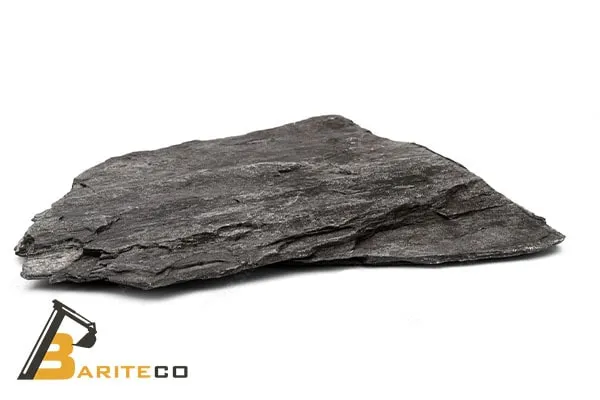

Comparative Analysis: Shale vs. Slate
| Property | Shale | Slate |
| Formation | Forms from the accumulation of fine-grained sediments (clay and silt) in low-energy environments (e.g., lakes, rivers). | Formed from the metamorphism (heat and pressure) of shale under moderate conditions, altering its texture and mineral content. |
| Texture | Fine-grained, soft, easily split into thin layers (fissility). | Fine-grained but much harder and more compact, with a cleavage that allows it to split into thin sheets. |
| Color | Often black, red, green, or gray, depending on the minerals and organic content. | Typically gray, but can be found in other colors like purple, green, and black due to mineral presence. |
| Composition | Primarily composed of clay minerals, quartz, organic matter, and sometimes carbonate minerals. | Composed of mica, chlorite, quartz, and feldspar, derived from shale’s metamorphic alteration. |
| Hardness | Soft, low hardness, easily breakable. | Harder, durable, and can withstand significant pressure and wear. |
| Uses | Primarily used for oil/gas production (shale oil), bricks, cement, and waterproofing. | Used as roofing material, floor tiles, and shingles due to its ability to split into thin sheets. |
| Structure | Layered structure, often with visible bedding planes. | Exhibits cleavage (ability to break along flat planes) due to metamorphism, making it ideal for splitting into slabs. |
| Permeability | Low permeability, which makes it a good barrier in oil and gas reservoirs. | Very low permeability, making it less prone to weathering and useful in construction. |
Key differences:
- Rock Classification: Shale is a sedimentary rock, while slate is a metamorphic rock formed by the metamorphism of shale.
- Physical Properties: Shale is softer and more easily split, while slate is harder, more durable, and splits into thin, flat sheets.
- Practical Applications: Slate is commonly used in construction, while shale is important in energy production (e.g., shale oil) and manufacturing.
Geological Relationship between shale and slate
Fundamentally, shale is the precursor to slate, which forms under higher pressure and temperature conditions. The metamorphism process alters the mineral composition and structure, resulting in the distinct properties that make slate a valuable construction material.
This transformation illustrates how Earth’s geological processes continuously modify rock types over millions of years, creating diverse materials with unique properties that serve various industrial, construction, and economic purposes.
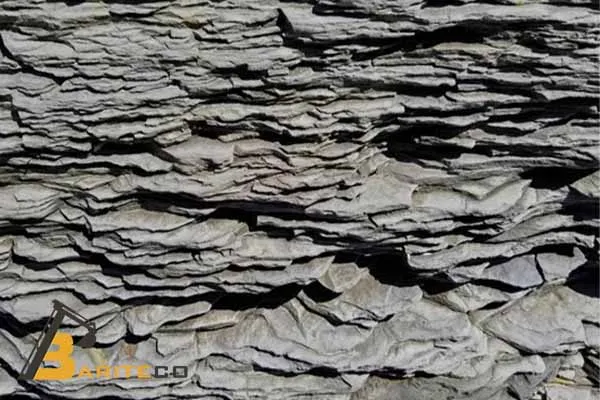
Oil Shale: Formation, Composition, and Extraction
Oil shale is a sedimentary rock that contains kerogen, a complex organic material that can be converted into oil and gas through thermal processing. It represents an important source of unconventional petroleum, especially in regions where conventional oil resources are limited.
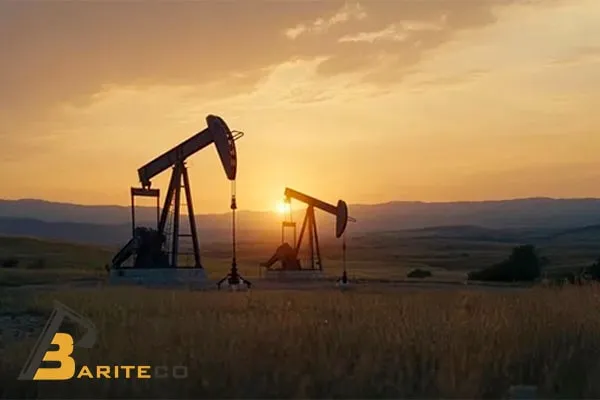
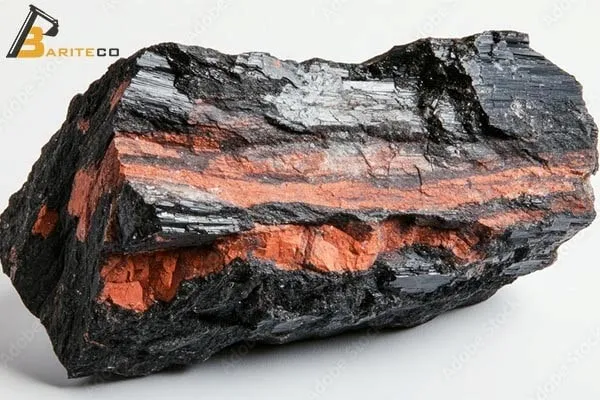
Formation of Oil Shale
Oil shale forms from the accumulation of organic-rich sediments in low-oxygen environments, such as ancient lakes or shallow seas. The formation process involves several steps:
Unlike conventional oil formation, the organic material in oil shale has not been exposed to sufficient heat and pressure to complete the transformation into liquid petroleum.
Composition of Oil Shale
Oil shale consists of various minerals and organic components:
- Kerogen: The primary organic material, which can be converted into oil when heated
- Clay minerals: Similar to other shales, oil shale contains fine-grained clay minerals
- Silica: Some oil shales contain significant amounts of silica in the form of quartz
- Carbonates: Calcite or dolomite may also be present
- Trace elements: Includes sulfur, phosphorus, and iron
The quality of oil shale is primarily determined by its kerogen content, measured as the amount of oil that can be produced per ton of rock.
Extraction of Oil from Oil Shale
Unlike conventional crude oil, oil shale requires thermal processing to extract usable hydrocarbons:
The extraction process, known as retorting, involves:
- Mining or in-situ access to oil shale deposits
- Crushing the shale (for ex-situ processing)
- Heating the oil shale to temperatures between 450°C and 500°C in the absence of oxygen
- Collection of the released hydrocarbons as they vaporize
- Condensation of these vapors to form shale oil
- Further refining of shale oil to produce usable petroleum products
In-situ processing techniques involve heating the oil shale while it remains underground, which can reduce some environmental impacts associated with mining.
Economic Potential
Oil shale holds significant potential as an energy source, especially in regions with large deposits, such as:
- United States (Green River Formation)
- China
- Estonia (where oil shale is a major energy source)
- Brazil
- Jordan
Environmental Concerns
The extraction and processing of oil shale present several environmental challenges:
- Water usage: Significant amounts of water are required for processing
- Land degradation: Surface mining can disturb large areas
- Greenhouse gas emissions: The energy-intensive extraction process produces substantial CO₂
- Waste disposal: Spent shale requires proper management
- Potential groundwater contamination: From leaching of minerals and organic compounds
Uses of Oil Shale
Oil shale and its derivatives have several applications:
- Shale oil production: The primary product, used as a substitute for conventional crude oil in refining
- Electricity generation: In some areas, oil shale is used in power plants to generate electricity by burning it directly
- Chemical production: Some by-products of oil shale processing can be used in the production of chemicals, such as ammonia or bitumen
- Construction materials: Spent shale can be used in cement production and other construction applications
Global Significance
Oil shale remains an important but controversial resource due to its economic potential and environmental impact. As conventional oil reserves decline, the development of oil shale resources may become increasingly important, particularly if technological advances can reduce the environmental footprint and economic costs of extraction.
Countries with significant oil shale deposits continue to research and develop more efficient and environmentally sound extraction methods to utilize this resource effectively.
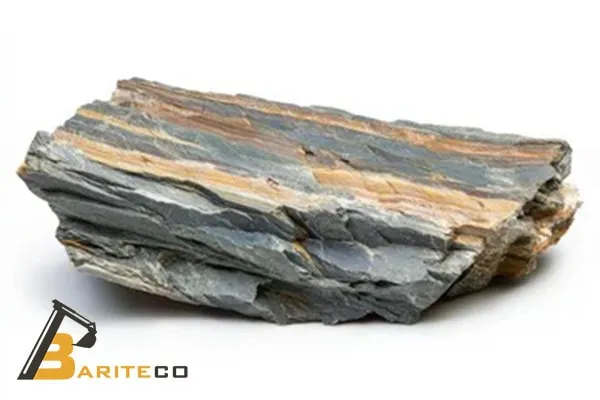
Gas Shale: Formation, Composition, and Extraction
Gas shale refers to shale formations that contain significant amounts of natural gas, specifically methane, trapped within the rock. This gas is often referred to as “shale gas” and has become one of the major sources of unconventional natural gas, transforming energy markets worldwide.
Formation of Gas Shale
Gas shale forms in much the same way as oil shale, through a complex geological process that occurs over millions of years:
- Deposition of organic-rich sediments (plant debris and algae) in low-oxygen environments such as ancient seafloors, lakes, or swamps
- Burial under layers of sediment, increasing pressure and temperature
- Transformation of organic material into kerogen through diagenesis
- With further heat and pressure (thermal maturation), kerogen decomposes into methane and other gases
- Gas becomes trapped in the tiny pores and natural fractures of the shale rock
Unlike conventional gas reservoirs where the gas migrates to more porous rocks, shale gas remains trapped in the source rock due to the extremely low permeability of shale.
Composition of Gas Shale
Gas shale consists of various organic and inorganic components:
- Organic matter (kerogen): The precursor material that generates methane when subjected to heat and pressure
- Methane: The primary component of shale gas, found in the pores and fractures of the shale
- Clay minerals: Fine-grained minerals that give shale its characteristic texture and low permeability
- Quartz and feldspar: Common minerals that make up the rock matrix and provide structural support
- Carbonates and sulfates: Some gas shales contain small amounts of calcium carbonate and sulfate minerals
The gas content and productivity of shale formations can vary significantly based on the thermal maturity of the organic matter, mineralogy, natural fracture networks, and total organic carbon (TOC) content.
Extraction of Shale Gas
Shale gas extraction involves advanced drilling and stimulation techniques that have revolutionized the natural gas industry:
The Hydraulic Fracturing Process
- Drilling: A well is drilled vertically down to the shale formation (often 1,000-3,000 meters deep), then horizontally through the gas-rich shale layer for up to several kilometers
- Well casing: Steel pipes (casings) are inserted into the wellbore and cemented in place to isolate the well from surrounding rock layers and groundwater
- Perforation: Small holes are created in the horizontal section of the well casing using perforating guns
- Hydraulic fracturing: A mixture of water, sand (proppant), and chemicals is pumped at high pressure into the well to create fractures in the shale
- Proppant placement: Sand particles prop open the fractures, creating pathways for gas to flow
- Flowback: Some of the fracturing fluid returns to the surface and is collected for treatment or disposal
- Production: Natural gas flows from the fractures into the wellbore and is brought to the surface for processing and distribution
Economic Importance
- Shale gas has become a major energy source, particularly in the United States
- Has transformed the US from a net importer to a net exporter of natural gas
- Created jobs and economic growth in regions with shale gas development
- Lowered natural gas prices, benefiting consumers and industries
- Reduced dependence on imported energy in some countries
- Served as a transition fuel with lower carbon emissions than coal for electricity generation
Environmental Concerns
- Water usage: Requires large volumes of water for fracturing operations
- Potential contamination of groundwater from improper well construction or surface spills
- Induced seismicity (earthquakes) associated with wastewater disposal
- Methane leaks during production and distribution (methane is a potent greenhouse gas)
- Surface disturbance from well pads, roads, and infrastructure
- Air quality impacts from equipment emissions and gas processing
The development of shale gas resources involves complex trade-offs between economic benefits and environmental risks that must be carefully managed through regulations, industry best practices, and ongoing monitoring.
Uses of Shale Gas
Shale gas has multiple applications across various sectors:
- Electricity generation: Natural gas power plants provide both baseload and peak demand electricity with lower emissions than coal
- Residential and commercial use: Heating, cooking, and water heating in homes and businesses
- Industrial processes: Manufacturing, food processing, and other industrial applications that require heat
- Petrochemical production: Feedstock for the production of plastics, fertilizers, and other chemical products
- Transportation fuel: Compressed natural gas (CNG) or liquefied natural gas (LNG) for vehicles
Global Significance
Gas shale has become a key resource in the global energy landscape, with major developments in:
- United States: Marcellus, Barnett, Haynesville, and Eagle Ford shales
- Canada: Horn River and Montney formations
- China: Sichuan Basin and other areas with significant potential
- Argentina: Vaca Muerta formation
- Europe: Various basins with potential, though development has been limited by environmental concerns and regulations
The future of shale gas development will depend on technological improvements, environmental regulations, and competition from renewable energy sources as countries work to reduce carbon emissions while meeting energy demands.

Environmental Impact of Shale Extraction
The extraction of shale, whether for oil or gas (shale oil and shale gas), has revolutionized energy production in many regions. However, this process involves several methods, particularly hydraulic fracturing (fracking) and thermal processing, which can have significant environmental impacts.
Detailed Environmental Concerns
Shale extraction poses substantial environmental challenges including water resource depletion and contamination, with each well requiring 1.5-16 million gallons of water mixed with potentially harmful chemicals. Air quality degradation occurs through emissions of methane, nitrogen oxides, volatile organic compounds, and particulate matter, contributing to regional pollution and climate concerns. The significant land development required for well pads, access roads, and infrastructure fragments habitats and disrupts ecosystems, though various mitigation strategies such as multi-well pad drilling, water recycling, and advanced monitoring are being implemented.
1. Water Usage and Contamination
- High water demand: Hydraulic fracturing requires large amounts of water, potentially straining local water resources, especially in dry regions
- Contamination risk: Chemicals in fracking fluid and produced water may contain toxic substances including heavy metals, radioactive elements, and methane
- Groundwater concerns: Potential contamination of aquifers and drinking water sources if well casings fail or surface spills occur
- Wastewater disposal: Management of large volumes of produced water presents significant environmental challenges
2. Air Pollution
- Methane emissions: Leaks during extraction, processing, and transportation of shale oil and gas
- Volatile organic compounds (VOCs): Release of chemicals contributing to air pollution and smog formation
- Dust and particulates: Construction, operations, and transportation release airborne particles
- Flaring and venting: Release of gases during well completion and operation
3. Induced Seismicity
- Minor earthquakes: Injection of high-pressure fluids during fracking or wastewater disposal linked to seismic events
- Infrastructure damage: Potential for damage to buildings, pipelines, and other structures
- Subsurface changes: Alteration of stress conditions in rock formations
4. Land Degradation
- Surface disturbance: Clearing land for drilling pads, roads, and infrastructure
- Habitat fragmentation: Disruption of wildlife corridors and migration patterns
- Soil erosion: Disturbance leading to increased runoff and sedimentation
- Landscape alteration: Visual impacts and changes to natural landscapes
5. Greenhouse Gas Emissions
- Carbon emissions: CO₂ released during extraction, processing, and consumption
- Methane leakage: Significant climate impact due to methane’s high global warming potential
- Energy intensity: High energy requirements for extraction processes add to overall carbon footprint
6. Community Impacts
- Noise pollution: Drilling operations and increased traffic create disruptive noise
- Health concerns: Potential exposure to pollutants affecting respiratory health and water quality
- Infrastructure strain: Increased traffic, road damage, and demands on local services
- Social changes: Rapid industrialization of previously rural areas
Water Resources Impact
Hydraulic fracturing requires between 1.5 and 16 million gallons of water per well, depending on the formation. This water is mixed with various chemicals and sand to create fracking fluid. The concerns include:
- Depletion of local water sources in water-stressed regions
- Chemical additives (though typically less than 2% of fracking fluid) can include acids, biocides, scale inhibitors, and friction reducers
- Flowback water and produced water containing dissolved minerals, hydrocarbons, and naturally occurring radioactive materials from deep underground
- Surface spills during transport or storage affecting soil and surface water
- Well integrity issues potentially leading to migration of gas or fluids into aquifers
Air Quality Concerns
Shale extraction operations release various air pollutants throughout the process:
- Methane: The primary component of natural gas, with a global warming potential 25-86 times that of CO₂ over different time periods
- Nitrogen oxides (NOx): From drilling equipment, compressors, and truck traffic
- Volatile organic compounds (VOCs): From various stages of extraction, storage, and transportation
- Particulate matter: From construction, traffic on unpaved roads, and diesel engines
- Hydrogen sulfide: A toxic gas sometimes present in oil and gas formations
These emissions contribute to regional air quality issues including ground-level ozone formation and can impact downwind communities.
Land Use and Ecosystem Impacts
Shale extraction requires significant land development:
- Well pads typically occupy 3-5 acres during drilling and 1-2 acres during production
- Access roads, pipelines, processing facilities, and compressor stations add to the footprint
- Habitat fragmentation disrupts wildlife movements and breeding patterns
- Edge effects alter species composition in adjacent natural areas
- Increased human activity and noise can drive sensitive species from the area
- Potential for invasive species introduction during construction and restoration
Mitigating Environmental Impacts
Various strategies are being employed and developed to reduce the environmental footprint of shale extraction:
- Multi-well pad drilling: Allowing multiple wells from a single pad to reduce surface disturbance
- Water recycling: Treating and reusing flowback and produced water for subsequent fracking operations
- Green completions: Capturing gases during well completion rather than venting or flaring
- Advanced monitoring: Leak detection and repair programs to identify and fix methane emissions
- Closed-loop systems: Eliminating open pits for fluid storage
- Seismic monitoring: Real-time monitoring to detect and prevent induced seismicity
- Non-toxic fracking fluids: Development of more environmentally friendly fracturing chemicals
- Site restoration: Comprehensive plans for returning land to natural or productive use after operations end
Regulatory Approaches
Effective management of shale extraction impacts requires robust regulatory frameworks. Different regions have adopted various approaches:
- Chemical disclosure requirements for fracking fluids
- Baseline water testing before drilling begins
- Setback distances from sensitive areas like homes, schools, and water sources
- Well construction standards to ensure integrity
- Wastewater management and disposal regulations
- Air quality monitoring and emissions controls
- Some jurisdictions have implemented moratoria or bans on fracking due to environmental concerns
Conclusion
While shale extraction has revolutionized energy production and provided significant economic benefits, it presents substantial environmental challenges. The management of these impacts requires a combination of:
- Continued technological innovation
- Effective regulatory oversight
- Industry best practices
- Comprehensive monitoring programs
- Community engagement
As the world transitions toward cleaner energy sources, balancing the economic benefits of shale extraction with environmental protection remains a significant challenge for policymakers, industry, and communities.
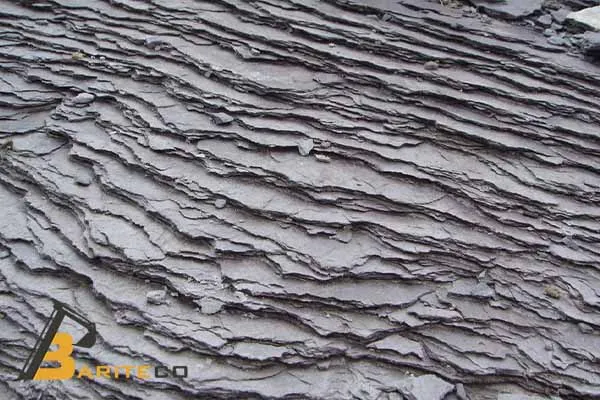
Economic Importance of Shale
Shale resources have revolutionized the global energy landscape and have become a significant driver of economic growth, particularly in countries with abundant shale deposits. The ability to extract oil and gas from shale formations through advanced technologies has transformed energy markets, created jobs, and reduced energy dependence for many nations.
Shale as an Energy Source
Shale has emerged as a critical component of the global energy mix, providing abundant and relatively accessible sources of both oil and natural gas:
Shale Gas Revolution
- Production boom: The United States increased its natural gas production by more than 50% since 2005, largely due to shale gas extraction
- Price impacts: Natural gas prices have decreased significantly, benefiting industries and consumers
- Power generation: Increased use of natural gas for electricity generation has helped reduce carbon emissions in some regions by displacing coal
- LNG exports: Countries with abundant shale gas have become exporters of liquefied natural gas, reshaping global energy trade
Shale Oil Transformation
- Production growth: Shale oil (tight oil) has driven significant increases in oil production, particularly in the United States
- Major formations: The Permian Basin, Bakken, and Eagle Ford shale plays have become some of the world’s most productive oil regions
- Technology-driven: Horizontal drilling and hydraulic fracturing have unlocked previously inaccessible oil reserves
- Market influence: Shale oil production has influenced global oil prices and reduced price volatility
Job Creation and Economic Growth
- Direct employment: Jobs in drilling, extraction, engineering, and technical services
- Indirect employment: Supporting industries like transportation, equipment manufacturing, and maintenance
- Induced jobs: Growth in retail, hospitality, housing, and other sectors due to increased local spending
- Wage benefits: Many shale industry jobs offer above-average wages, boosting local purchasing power
- Regional revitalization: Economic revival in previously declining industrial and rural areas
Energy Independence and Security
- Reduced imports: Decreased reliance on foreign oil and gas, particularly from politically unstable regions
- Geopolitical leverage: Greater negotiating power in international relations due to energy self-sufficiency
- Supply stability: Domestic production provides insulation from international supply disruptions
- Strategic advantage: Energy independence strengthens national security and economic stability
- Export capabilities: Transition from net importer to exporter of energy resources
Lower Energy Prices
- Utility costs: Reduced electricity and heating costs for households and businesses
- Manufacturing advantage: Lower energy costs for energy-intensive industries, improving competitiveness
- Transportation costs: Reduced fuel prices benefiting transportation and logistics sectors
- Consumer benefits: More disposable income for households due to lower energy bills
- Price stability: Less volatile energy prices due to increased domestic supply
Tax Revenue and Public Finance
- Production taxes: Severance taxes, royalties, and production fees for state and local governments
- Corporate taxes: Income tax revenue from profitable energy companies
- Property taxes: Increased property values and new infrastructure adding to the tax base
- Public services: Funding for schools, roads, hospitals, and other essential services
- Sovereign wealth: Some regions have established funds to preserve wealth for future generations
Technological Innovation and Investment
The shale revolution has been driven by and continues to spur technological advancements:
- Drilling innovations: Multi-stage fracturing, longer horizontal wells, and pad drilling have improved efficiency and reduced costs
- Digital technologies: Advanced sensors, real-time monitoring, big data analytics, and automation improving operations
- Environmental technologies: Innovations in water treatment, recycling, emissions monitoring, and leak detection
- Capital investment: Billions of dollars in private and public investment in infrastructure, technology, and development
- Research and development: Continued improvement in extraction techniques and environmental safeguards
Innovation Spotlight: The cost to drill and complete a shale well has decreased by as much as 60% since 2014 due to technological advancements and operational efficiencies, making previously uneconomic formations viable for development.
Shale Industry Investment Trends

Contribution to Petrochemical Industry
Shale gas has revitalized the petrochemical sector, particularly in the United States:
- Feedstock for ethylene: Natural gas liquids from shale gas, particularly ethane, serve as key feedstocks for ethylene production
- Manufacturing renaissance: Lower-cost inputs have spurred new investment in chemical manufacturing facilities
- Plastics production: Expanded capacity for producing plastics, synthetic fibers, and other petrochemical products
- Export opportunities: Competitive advantage in global markets for petrochemical products
- Industrial clusters: Development of integrated industrial complexes around shale processing
Geopolitical Influence
The shift in global energy production due to shale has reshaped international relations:
- Market power: New influence in global energy markets for countries with significant shale resources
- OPEC dynamics: Reduced influence of traditional oil-producing cartels
- Energy diplomacy: Ability to support allies through energy exports
- Trade balances: Improved trade balances for countries that have reduced energy imports
- International cooperation: Technology sharing and development partnerships for shale extraction
Challenges and Considerations
While the economic benefits of shale are substantial, several challenges must be addressed:
- Environmental impacts: Water use, potential contamination, methane emissions, and land disturbance that may create economic costs if not properly managed
- Infrastructure needs: Significant investment required in pipelines, storage, processing facilities, and transportation networks
- Community impacts: Rapid development can strain local services, housing, and infrastructure
- Market volatility: Boom-and-bust cycles can create economic instability in regions heavily dependent on shale
- Long-term sustainability: Question of how long shale resources will last and their role in a carbon-constrained future
- Regulatory balance: Finding the right approach to regulation that protects the environment while allowing economic development
Addressing these challenges through sustainable practices, diversification strategies, and appropriate regulations is crucial to ensuring that the economic advantages of shale extraction provide long-term benefits.
Global Perspective
While the United States has been at the forefront of the shale revolution, other countries are exploring their potential:
- Argentina: Developing the Vaca Muerta formation, one of the largest shale oil and gas reserves outside North America
- China: Working to develop its extensive shale gas resources to reduce coal dependence and air pollution
- Canada: Significant shale oil and gas development, particularly in Alberta and British Columbia
- Russia: Beginning to explore its vast shale potential despite already having abundant conventional resources
- Mexico: Shale resources that extend from the Eagle Ford in Texas into northern Mexico
- United Kingdom: Ongoing exploration of shale potential, though facing regulatory and public acceptance challenges
Conclusion
The economic importance of shale resources extends far beyond the energy sector, influencing national economies, international relations, and global markets. The shale revolution has demonstrated how technological innovation can unlock previously uneconomic resources, creating jobs, wealth, and strategic advantages.
However, the full realization of shale’s economic benefits depends on addressing environmental concerns, managing social impacts, and navigating the transition to a more sustainable energy future. With proper management and continued innovation, shale resources can provide significant economic benefits while serving as a bridge to cleaner energy systems.
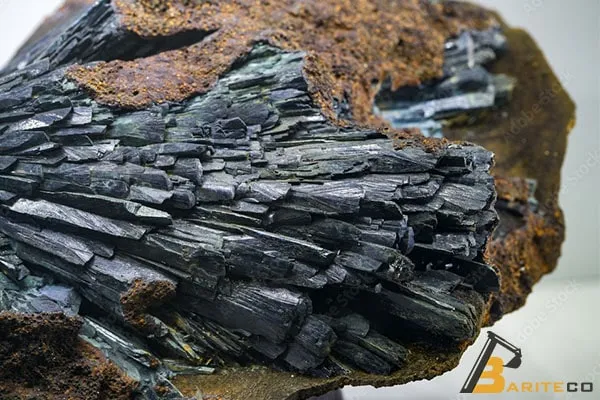
Future of the Shale Industry
The future of the shale industry looks promising, with significant advancements expected in technology, production techniques, and global energy markets. However, it also faces challenges related to environmental concerns, regulatory changes, and market volatility. Below are some key trends and factors that will shape the future of the shale industry:
Continued Technological Advancements
The shale industry’s future will be shaped by significant technological innovations including improved horizontal drilling, multi-stage fracturing, and enhanced oil recovery techniques that increase efficiency and recovery rates. Automation, artificial intelligence, data analytics, and advanced water management systems will further optimize operations while reducing environmental impacts and operational costs.
Improved Drilling Techniques
The shale industry will continue to benefit from innovations in horizontal drilling, hydraulic fracturing, and well stimulation. Advancements such as multi-stage fracturing and enhanced oil recovery (EOR) techniques will enable more efficient extraction, reducing costs and improving recovery rates.
Automation and AI
The adoption of automation, artificial intelligence (AI), and data analytics will streamline operations, reduce human error, and optimize production. Automated drilling rigs, real-time monitoring, and predictive analytics will enhance efficiency and safety in shale operations.
Water and Waste Management Innovations
To address water usage and wastewater disposal concerns, the industry will adopt closed-loop systems for water recycling and advanced treatment technologies for wastewater, reducing environmental impact and costs.
U.S. Shale Oil Production Forecast
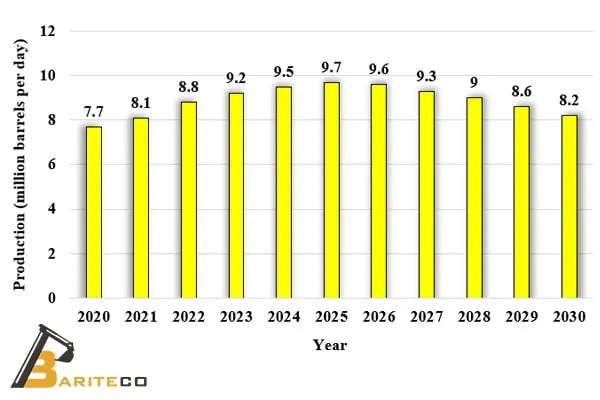
Shift Toward Cleaner Energy
The shale industry’s future will increasingly prioritize decarbonization through carbon capture and storage technologies, methane emissions reduction strategies, and green innovations such as solar-powered pumps and electric fracking fleets that can reduce emissions by up to 99% compared to traditional diesel-powered equipment.
Decarbonization
The shale industry will face increasing pressure to reduce its carbon footprint. This may include efforts to capture and store carbon emissions (carbon capture and storage (CCS)) during shale oil and gas production. The adoption of low-carbon technologies and the integration of renewables into shale operations could help balance environmental concerns with energy demand.
Methane Emissions Reduction
Reducing methane leaks, a potent greenhouse gas, will become a priority. New technologies for methane detection and capture are expected to become more widespread, helping the industry meet stricter environmental regulations.
Green Innovation: Some industry leaders are already implementing solar-powered pumps and electric fracking fleets that reduce emissions by up to 99% compared to traditional diesel-powered equipment.
Global Expansion and Energy Export
The shale industry is projected to expand globally beyond North America, with countries like Argentina, China, and Russia developing their own resources, while U.S. LNG exports continue growing to meet rising demand in Europe and Asia.
Shale as a Global Energy Resource
The shale industry is likely to expand beyond regions like the U.S. and Canada, with countries such as Argentina, China, and Russia exploring their own shale resources. International shale oil and gas production could contribute to global energy supply diversification and enhance energy security in other regions.
Increased LNG Exports
The U.S. has already become a major exporter of liquefied natural gas (LNG), and this trend is expected to continue. As shale gas production grows, global demand for LNG is likely to increase, with shale-producing nations seeking to expand their export markets, especially in Europe and Asia.
Global Expansion: Developing shale resources across different continents
Market Volatility and Investment Shifts
Shale industry faces dual challenges of oil price fluctuations and shifting investor preferences toward more sustainable energy companies.
Price Fluctuations
The shale industry is heavily influenced by global commodity prices, especially oil and gas. Future production rates may be impacted by market volatility, including price crashes and oversupply. Shale companies will need to adapt to these fluctuations by improving cost efficiency and exploring new revenue streams.
Investor Sentiment
As climate concerns increase, there may be a shift in investment away from fossil fuels, leading to greater scrutiny of the shale industry. Investors may prioritize companies that are committed to sustainable practices and energy transition strategies, such as investing in renewable energy alongside shale production.
Regulatory and Environmental Challenges
Future shale operations face intensifying regulatory pressure, stricter environmental standards, and public scrutiny regarding water usage, emissions, land disruption, and climate impacts, requiring industry adaptation through cleaner technologies and transparent community engagement.
Stricter Environmental Regulations
Governments and regulatory bodies will likely introduce stricter environmental regulations in response to growing concerns over pollution, water usage, and greenhouse gas emissions. The industry will need to adapt by investing in cleaner technologies, reducing water consumption, and improving environmental performance.
Public Perception and Social License to Operate
The shale industry will face increased pressure from environmental groups and local communities to demonstrate that it can operate sustainably. Companies will need to engage in transparent communication and adopt best practices for minimizing environmental and social impacts.
Key Environmental Considerations
- Water management: Reducing freshwater usage and preventing contamination
- Air quality: Controlling emissions of methane and volatile organic compounds
- Land use: Minimizing surface disruption and restoring sites after operations
- Induced seismicity: Managing and mitigating risks of earthquakes from wastewater disposal
Climate impact: Addressing concerns about the carbon footprint of shale operations
Environmental Regulations Impact

Integration with Renewable Energy
Shale gas is evolving to complement renewable energy through hybrid systems, providing on-demand power when wind and solar production is insufficient.
Hybrid Energy Systems
As the world transitions toward clean energy, the shale industry may become part of hybrid energy systems that combine natural gas with renewables such as wind and solar power. Natural gas from shale can act as a bridge fuel to support the integration of intermittent renewable sources into the energy grid.
Energy Storage and Shale Gas
Advances in energy storage technology could allow shale gas to play a critical role in balancing supply and demand, particularly during periods of low renewable energy production.
Integration Example: Some energy companies are developing integrated power systems where shale gas plants can rapidly scale up or down to complement solar and wind production, creating more stable and reliable clean energy grids.
Increased Focus on Localized Energy Production
Shale resources enable decentralized energy systems that reduce transmission losses and enhance reliability in remote communities.
Decentralized Energy Systems
Shale could play a role in the decentralization of energy production, providing localized energy solutions for communities and industries. Small-scale, distributed natural gas production from shale may help reduce transmission losses and ensure energy reliability in remote areas.
Local Energy: Community-centered energy production using shale resources
Conclusion: Balancing Growth with Sustainability
The future of the shale industry will be characterized by a delicate balance between continued growth and increasing sustainability demands. Success in this evolving landscape will depend on:
- Technological innovation: Continuous improvement in extraction efficiency, environmental performance, and cost reduction
- Adaptability: Ability to navigate changing market conditions, regulatory requirements, and investor expectations
- Integration: Finding synergies with renewable energy and participating in the broader energy transition
- Transparency: Clear communication with stakeholders about environmental impacts and mitigation efforts
- Diversification: Expanding beyond traditional models to include cleaner applications and production methods
While the shale industry faces significant challenges, particularly related to environmental concerns and the global shift toward decarbonization, technological innovations and strategic adaptations could enable it to continue playing an important role in the global energy mix for decades to come.
Technology Adoption in Shale Industry
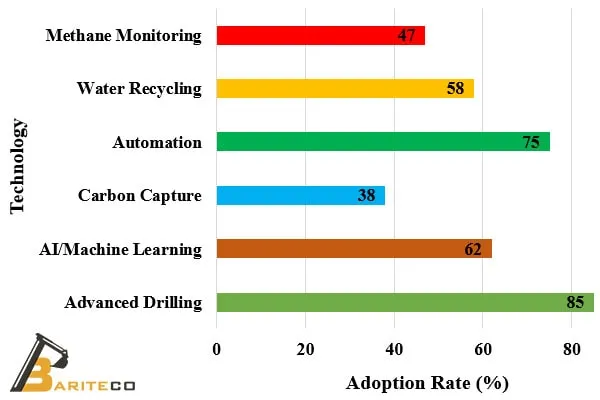
Conclusion
Shale rock represents a foundational sedimentary formation that has transformed global energy production and industrial applications. Through its various forms including oil shale, gas shale, and specialized types like black shale this abundant resource has revolutionized energy security and economic development worldwide. Advanced extraction technologies, particularly hydraulic fracturing, have unlocked previously inaccessible reserves of unconventional oil and natural gas.
Looking forward, the shale industry faces the dual challenge of maximizing economic benefits while minimizing environmental impacts. Success will increasingly depend on implementing sustainable practices, developing cleaner technologies, and maintaining appropriate balance between resource extraction and environmental protection. As global energy needs continue evolving, shale will maintain its significance both as an energy source and industrial material, shaped by technological advancement and growing environmental awareness.
We value your thoughts on this article about shale rock. Please share your opinion about the content and topic in the comments section below. If you have any experience with shale applications, we would appreciate hearing about it. Your feedback helps us improve our content and provides valuable information for other readers.
